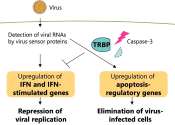Bacterial proteins shed light on antiviral immunity
A unique collaboration between two UT Southwestern Medical Center labs—one that studies bacteria and another that studies viruses—has identified two immune proteins that appear key to fighting infections. The findings, ...









